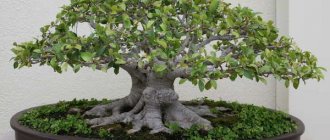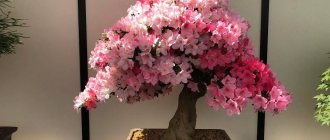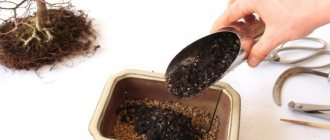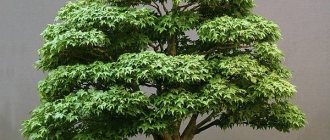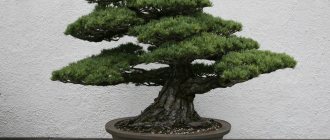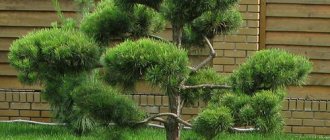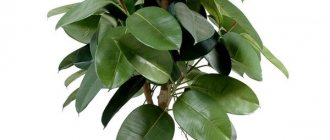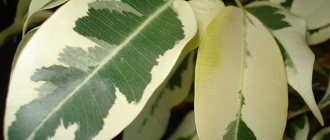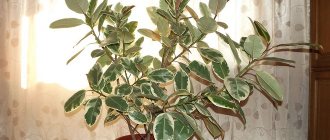However, that's exactly it! Moreover, work on such a bonsai will not last 15–20 years, but much less. The reason is the enviable pliability of the tree, in favorable conditions:
- excellent at taking aerial roots;
- healing wounds on the trunk;
- forming new branches to replace the cut ones;
- amenable to formation using wire and twine.
Even a tree that has grown to standard size in the hands of an enthusiast can become an original bonsai in a few years. What does it take to turn the most common ficus benjamina on our windows into a bonsai?
First of all, you need to create suitable conditions for the plant. Then a lover of Japanese art will have to master the care and basics of formation on an adult plant. When all the stages have been completed, you can move on to practice and create your own composition.
How to do it: basic rules for growing bonsai
So, you have already selected the ficus of the desired type and even decided what shape you want to give it. But before you start creating bonsai, you need to familiarize yourself with the rules for caring for them.
Choosing a container for planting
Looking at the finished bonsai trees, you probably noticed the containers in which they were grown. When choosing a pot for bonsai, it is very important to maintain harmony in the shape of the plant and the size of the container. The basic rule when creating a traditional bonsai: in most cases, the container should be shallow, almost flat, but wide enough. This way you can avoid the growth of the root system, which entails an increase in the crown and leaf mass.
For planting bonsai, you should choose shallow, almost flat pots.
Soil for planting and growing bonsai
Based on the size and shape of the containers for this type of plant, the soil requirements for them are also determined. You can provide the ficus with the most comfortable existence, close to natural conditions, by planting it in natural soil. Buy ready-made soil for ficus and palm trees at the store or prepare it yourself. To do this you will need only 3 components:
- sand;
- clay;
- humus.
Sand, clay and humus are essential components of a bonsai substrate.
Sand should be of two types - coarse (sand grains 3–4 mm in size) and fine (sand grains 1–2 mm in size):
- Coarse sand will provide drainage, through which excess water during irrigation will flow into the pan. The layer of coarse sand at the bottom of the container should be about 2 cm. You should not take sand with a larger fraction: it will quickly become clogged with small particles of clay, and water drainage will become difficult. Finer sand will simply spill through the mesh on the drainage holes of the container (the size of its cells is no more than 3 mm).
- Fine sand is part of the substrate, sometimes together with coarse sand. When preparing the soil mixture, keep in mind that the proportion of sand in it should be at least 20%, maximum 60%. The more fine sand there is in the soil, the lighter it is, which means the roots in it will not rot. There is also a minus: the plant in such soil can dry out, since it does not retain water for a long time.
Good, high-quality sand of any fraction can be obtained in several ways. For example, get it from the bottom of the river. If this is not possible, then take the red bricks and crush them, then sift them well. Often, instead of sand, fine expanded clay (about 3 mm in diameter) is used.
Now about the clay. Its main function as part of a soil mixture is to retain moisture for the root system and release it at the right time. Japan traditionally uses special types of clays, and bonsai growers from other countries have adopted this practice. The most suitable clay is “Akadama” - a granular substrate whose particle size is 4–6 mm. They absorb a large amount of moisture, but do not get wet or stick together, allowing air to pass through perfectly.
Japanese clay "Akadama" is recommended as a base soil for bonsai
Humus, leaf soil, peat - these soil components will provide your future bonsai with nutrients.
Where to place the ficus after purchase
The plant is very modest in size, but demanding in terms of location. In its natural environment, ficus grows as a tall tree, but at home it rarely grows above 1.5 m. It is not recommended to move the flowerpot more than twice a year (winter - summer).
Important! A relatively common problem is the dropping of leaves after purchase as a sign of protest. Don’t think that you bought a low-quality flower. As you know, ficus Moklame really does not like to change place, flowerpot and experience a change in lighting, which is almost inevitable when moving. To prevent this from happening, try to approach transportation issues carefully.
Loves shade and indirect diffused light. A complete lack of sunlight will lead to slower growth and falling leaves, and an excess of sunlight will lead to burns on the leaves. For outdoor planting, the east and west sides of the house are best. Otherwise, the ficus is unpretentious and not capricious, suitable even for beginners.
What should the soil be like?
The soil for growing ficus Moklame must have good moisture and breathability. Flower growers are recommended to use special soils with neutral acidity. The substrate can be prepared independently from the following components:
- turf land (2 parts);
- deciduous soil (1 part);
- peat (1 part);
- sand (1 part).
Important! For 2 months after transplantation, ficus can do without feeding.
Lighting
Ficus Moklame is a shade-tolerant crop. It can be grown in indirect light. Lack of light manifests itself in the form of faded leaves. In this case, it is necessary to organize lighting. For this purpose, gardeners can use a phytolamp.
Humidity and temperature
The optimal air temperature in the room where the ficus grows should be about 17-24 degrees. In winter, the tree may suffer due to hypothermia. During this period, it is recommended to maintain the temperature within 16-20 degrees. It is best to place the pot on a wooden stand. Humidity in the room should be between 50-70%.
Advice! In hot weather, ficus needs to be sprayed 2 times a day.
Capacity requirements
Each time when replanting a ficus, take a pot with a diameter 3-5 cm larger than the previous one.
Given the large size of indoor flowers, a stable clay container is the most suitable option.
Watering
The intensity of watering depends on many factors:
- season - the frequency is increased in the summer (up to 3 times a week) and significantly reduced in the winter (up to 1 time a month);
- age - an adult plant requires 2 times more water than a young seedling;
- stage of development - during active growth in the spring, watering procedures are increased, and in winter, during the dormant period, they are reduced;
- Reducing the dimensions of the pot, large containers require an increased volume of water.
Water the indoor flower when the top layer of the soil mixture dries. Excess moisture is drained from the pan 0.5 hours after watering to avoid stagnation and rotting of the root system.
Additionally, in the summer, foliage is sprayed and a shower is provided once a month.
Feeding
The flower needs nutritional supplements:
- in the spring, mainly nitrogen-containing fertilizers are applied, which activate the growth of green mass;
- In summer and autumn, flower crops are fed with phosphorus and potassium to intensively form the root system, increase immunity and regulate water balance.
In winter, when at rest, ficus is not fertilized.
Crown formation
The crown can be given a fancy shape
They begin to form a ficus crown in the spring, so that the newly grown shoots have time to grow and get stronger before winter, when the activity of the plant decreases.
Pruning can be aimed at stimulating the growth of axillary (lateral) shoots or terminal (upper) buds.
- In the first case, the top is shortened, creating a stimulus for the formation of branches from the sides and the expansion of the lush crown.
- In the second, the removal of lateral shoots stimulates the growth of the flower in height.
Forming work must be carried out with gloves, because... The secreted milky juice causes allergic reactions.
Moklame is often formed in the form of a bonsai, because this species is predisposed to branching:
- cut the central shoot by 10 cm;
- the entire lower tier is removed, leaving only the top;
- when the side branches reach the length of the main shoot, they are shortened;
- the pot is periodically turned to the sun with different sides to obtain a bevel.
When pruning, all sections are washed under running water to remove any milky juice that appears and sprinkled with crushed activated carbon.
How to grow bonsai from Ficus Microcarpa
Although Ficus Benjamina is considered the most popular when creating a bonsai tree, other species also give good results. For example, Ficus Microcarpa, which is also known by the names: Ginseng (ginseng), blunted, Chinese banyan and even “strangler” - for its ability to entwine surrounding plants with aerial roots and inhibit their growth. The thick trunk of the ficus Microcarpa seems to consist of several intertwined thinner trunks, which attracts bonsai lovers. However, in reality these are thickened aerial roots.
A characteristic feature of ficus is Microcarp - a powerful root system, which is often mistaken for a trunk.
Ginseng for growing bonsai is in many ways even simpler than Ficus Benjamin. To speed up the process of rooting and growth of aerial roots, form a greenhouse over the container with the planted shoot. For example, cover the cutting with a glass jar of suitable size or put a transparent plastic bag over the pot. Every day, open the greenhouse for 20–30 minutes for ventilation.
In July, the ficus Ginseng needs to be replanted. Be sure to shorten the roots by a quarter before planting in new soil.
Ficus Microcarpa needs plenty of sunlight, but direct rays are best avoided. In autumn and winter, provide the plant with fluorescent lamps to keep the daylight hours within 14–16 hours.
Please note that this type of ficus does not like dry hot air. Place the bonsai at a considerable distance from heating devices and heating radiators. Keep the plant away from window sills to protect it from cold drafts.
Do not forget that the leaves of the Ginseng ficus are moderately poisonous. Choose a place for the plant that is inaccessible to children and pets.
The optimal height of a bonsai from the ficus Microcarp is 50 cm. When the tree reaches this size, you can begin to form the crown. As a rule, this occurs in the 3rd–4th year of growth. By this time, the aerial roots will also become quite large. Be sure to prune during growth so that the tree does not stretch upward.
Ficus Microcarpa is incredibly hardy and grows very quickly. Trees appear wherever seeds fall. The plant is found on the roofs of multi-story buildings, on rocks and even in sidewalk cracks.
Radical pruning of the ficus Microcarp allows you to give the bonsai a more spectacular shape.
Do not be alarmed if your Microcarpa ficus begins to shed leaves en masse - this is a characteristic phenomenon for this species. Ginseng's foliage lives for 3 years, after which it falls off, but pretty soon the plant acquires a new crown. And yellowing of the leaves, starting from the lower ones, signals that it is time for the plant to fertilize.
Video: bonsai formed from ficus Ginseng
Preparing for landing
First you need to cut a stalk from the top of the ficus. It must have at least 4 leaves and at least 2 growing points from which the plant will begin to take aerial roots.
Then the ends of the cut cuttings need to be treated with either crushed chalk or activated carbon. Let them dry completely.
Now the sprouts need to be immersed in water or a special solution for growing the root system. The water temperature should not be lower than 25-27 ºС. The future bonsai should be positioned so that there is enough natural sunlight.
After the ficus has taken root, you need to lay a net in the bonsai container you have chosen, sprinkle coarse river sand on top, then pour out the substrate.
Now you need to place the plant where it will grow, straighten the roots, place a stone under them and sprinkle with earth. Water thoroughly.
After about 4 months have passed, the ficus has taken root well, begin to expose the roots by gradually removing a layer of soil from them.
You can grow several plants in a pot at once by intertwining their trunks. This will create a very unusual bonsai.
Bonsai from other types of ficus: Bengal, Fig, Panda, Rubber, etc.
You can create an original and spectacular bonsai from other types of ficus, but you need to take into account some nuances:
- Bengal ficus. It is also called banyan because of its specific shape: one plant looks like a whole grove. This is why the Bengal ficus is valuable among bonsai lovers. You can also form a grove from other species, but it is easier to get a bonsai from the Bengal ficus, and it will look more impressive. Leaves with a variegated pattern will add decorativeness to the composition.
- Ficus Panda has very dense leaf plates, giving the bonsai a special originality. The tree tolerates dry air very calmly, so it will take root well in a city apartment.
- Fig ficus, or Carica (wineberry, fig tree). This species has thick branches, so pruning the plant is difficult. The leaves are large, but decrease in size over time - this is a plus for bonsai. The downside is that the fig ficus sheds its leaves in the winter. But in the summer it quickly gains new strength, especially if it is taken out into the open air.
- Ficus rubber plant. Not all representatives of this species are suitable for creating bonsai. Experts prefer to use specially bred hybrids with different color patterns on the leaves. The leaves of the rubber ficus grow quickly and are arranged in a spiral, which is good for the formation of a bonsai tree. The plant is demanding of lighting and does not tolerate changing it, so you should keep the rubber ficus bonsai in the same place. Do not forget that the juice of this species is poisonous: do the pruning with gloves and sprinkle the cut areas with activated carbon.
- The rusty-red ficus is distinguished by smooth reddish bark and leaves covered on the inside with red hair. This species grows very slowly, but you do not have to do frequent pruning. The stems of the Rusty Red Ficus, like the Ficus Bengali, form a banyan tree, but not very pronounced. The plant is very hardy, mistakes in care are not critical.
Flower design
From a design point of view, the ficus bonsai is such an individual and elegant plant that it hardly needs companions. It would be nice to purchase a special stand and pot and decorate the composition in a landscape style. By adding a few additional decorative elements. Work with lighting, additional lighting. You can create a composition of several ficus bonsai, of different sizes or different varieties and types of ficus. You can also make a ficus benjamina bonsai with your own hands. By combining them with additional decorative elements, in the same style or different, but uniting them into a whole. Good luck to you.
Getting rid of diseases and pests
The most common problems that beset bonsai trees grown from ficus trees are drying out roots and falling leaves. Other problems may occur, but they are all caused by pests or diseases.
- The most malicious and most frequent enemies of ficus are scale insects. If you notice black or brown cones on the branches with a coating similar to wax, know that they are where insects are located.
- Another person who likes to parasitize ficus trees is mites. Take a closer look at the leaves of the plant. If you see red or brown moving dots, then ticks have already come to you. For now, there is nothing particularly to be afraid of: there are still a few insects, you can deal with them by wiping the leaves and branches with a soapy solution. But if you find a cobweb on a ficus tree, you will have to work more thoroughly.
Drying roots and falling leaves of a ficus bonsai eloquently indicate a plant disease - Mealybugs appear on ficus trees less often than their parasitic counterparts mites and scale insects, but this does not make it any easier for you and me. You can find them in the form of fluffy white formations on the roots and at the base of the leaves.
If we are talking about other plants, then insecticides are used to treat them from the listed misfortunes. The problem with ficus trees is that they do not tolerate substances containing malathion. Therefore, when choosing an insecticide, choose one that contains neem oil.
If the ficus bonsai began to lose leaves, then the reasons may be as follows:
- high humidity;
- excessive dryness;
- frequent drafts;
- regular exposure to bright sunlight.
If the ficus leaves begin to turn yellow, you should change the watering or lighting mode
Move the ficus pot to a lightly shaded area out of direct sunlight. There should be no drafts or access to cold air in the room; there should be a constant temperature within +19 - +22°C. Let the soil dry thoroughly, and only then water the plant with a small amount of water, but often. After 3-4 weeks, the leaves will stop falling.
If the roots of a ficus bonsai begin to dry out, then this is most likely due to improper watering. Try spraying it generously with a spray bottle for a while (2-3 weeks) after the soil has completely dried out, so that it is thoroughly moistened. The next watering is in the same way, after the soil has noticeably dried out.
Trimming
Pruning branches not only limits growth, but also encourages sap flow to different parts of the plant. There are many different forms of ficus bonsai known, such as a tree with a twisted trunk, a floating tree or a tree with bare roots, and so on. Pruning is carried out in early spring, before the plants begin to grow. It is best to prune them even earlier - before trimming the roots. The tops of the stems are pinched back throughout the active growing season as this promotes the development of small leaves.
Maintaining the required humidity
For ficus microcarp, it is necessary to maintain a high level of humidity constantly, regardless of the time of year. Spraying ficus leaves daily will help create the desired moisture limit. It is important to spray the foliage and not the tree trunk. Depending on the time of year, this procedure should be performed once a day, more often in summer, less often in winter. Wiping the leaves of the plant every day will help with hydration. To do this, you need to moisten a soft cloth in clean water and wipe all the leaves one by one.
Temperature for care
The most suitable conditions for caring for microcarp bonsai and its further growth are temperature conditions ranging from 16 to 23 degrees. The plant categorically does not tolerate sudden changes in temperature and drafts. But also, this representative of the flora does not like too hot a climate, in which rapid dehydration of the soil occurs. If the temperature in the room where the plant is located exceeds 25 degrees, then additional humidification of the air and soil is necessary. Many professional plant growers use air humidifiers for such cases, but you can get by with a simple sprayer. If all these conditions are not met, the plant will be under constant stress and will shed all its foliage.
Domestic varieties
There are several varieties of Ficus microcarpa. They differ from each other in the shape of the crown, foliage, height and variegated color of the leaf plate. The most popular in home floriculture:
- "Green Graham" has a very dense and dense crown.
- “Westland” is a leaf plate elongated to 10-12 cm.
- "Moklame" is a beautiful plant with slightly rounded dark green leaf blades.
- "Variegata" is one of the most interesting forms of ficus, in which the leaves have a variegated white-green or golden-green color.
Ficus microcarpa is a spectacular plant grown using the bonsai technique that will take a place not only on your windowsill, but also in your heart. It will undoubtedly impress you with its intricately curved roots and dense glossy leaves.
Description of the plant
Ficus microcarpa is also called: gajumaru, Chinese banyan, Malayan banyan, Indian laurel, curtain fig.
Also read: Monilaria - bunny ears
In subtropical forests, ficus is an evergreen tree and reaches an impressive height of 25 m. Moreover, it has a spreading crown. In its natural growing environment, ficus leads an epiphytic life, relying on aerial roots.
Ficus microcarpa, grown as a houseplant, has the appearance of a miniature tree. It is for this reason that it is grown as a bonsai. Of particular interest to most lovers of this plant are its roots, which form the trunk. It is thanks to the “trunk” that such a bizarre and unique look is acquired.
The leaves of this ficus also deserve special attention - they are very dense, glossy, and have a beautiful rich dark green color. The leaf shape is oval, pointed at the ends.
With proper care, in exceptional cases, ficus microcarpa can surprise its owner with fruits - they are small, yellow-green in color. As the fruit ripens, its color changes to purple.

